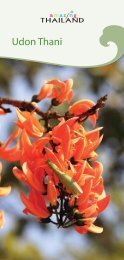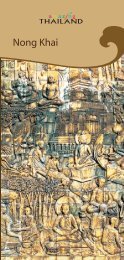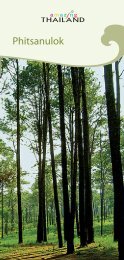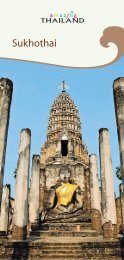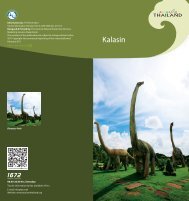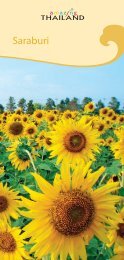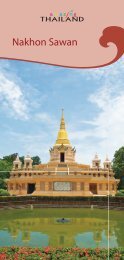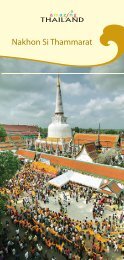You also want an ePaper? Increase the reach of your titles
YUMPU automatically turns print PDFs into web optimized ePapers that Google loves.
80<br />
Timeless Natural Beauty of<br />
the Old Ban Tai-Ban Khai<br />
Community<br />
Ban Tai is one of the three earliest<br />
settlements on <strong>Pha</strong>-<strong>ngan</strong> island, presumably<br />
since late-Ayutthaya period. Chinese<br />
emigrants, mostly Hainanese fishermen,<br />
came to settle and work in the area, blending<br />
with local people through marriage. Over<br />
several generations, the village has today<br />
become one of the largest in <strong>Ko</strong> <strong>Pha</strong>-<strong>ngan</strong>.<br />
Traces of ancient civilization still<br />
survive in temples, manifesting a strong<br />
Buddhist Chinese community. There are a<br />
lot of old temples, for instance Wat Nai,<br />
Wat Nok, Wat Pho, Wat KaoTham, and Chinese<br />
shrines situated across the village. It is<br />
supposed that these religous places were<br />
built at the very same time between late-<br />
Ayutthaya period to early-Rattanakosin period.<br />
Wat Nai is the oldest temple in Ban Tai<br />
community. Built in the late-Ayutthaya<br />
period, the now-uninhabited temple has<br />
been included in the monastic territory of<br />
Wat Pho in Mu 3, Ban Tai sub-district, <strong>Ko</strong> <strong>Pha</strong>-<strong>ngan</strong> district. The site reveals<br />
archaeological evidences, in particular the three outworn pagodas, two of which have<br />
been ruined by time that only their pedestals remain visible: One is made of coral<br />
stone hugged by a Bodhi tree, the other is a small brick structure. The only one which<br />
is relatively complete is a square brick cement-bounded pagoda with rabbeted<br />
angles, decorated with Chinese ceramic crockeries. Its high pedestal has two door facades<br />
on each of the four sides. The excavation unveiled a horde of bluewares from Ming<br />
and Qing dynasties, leading to the hypothesis that this area was a residential<br />
area since Ayutthaya era up to the reigns of King Rama III and IV of Rattanakosin.<br />
Townspeople took part in building these monuments at the center of their community,<br />
manifesting the firm relationship among Thais and Chinese living together.<br />
81




